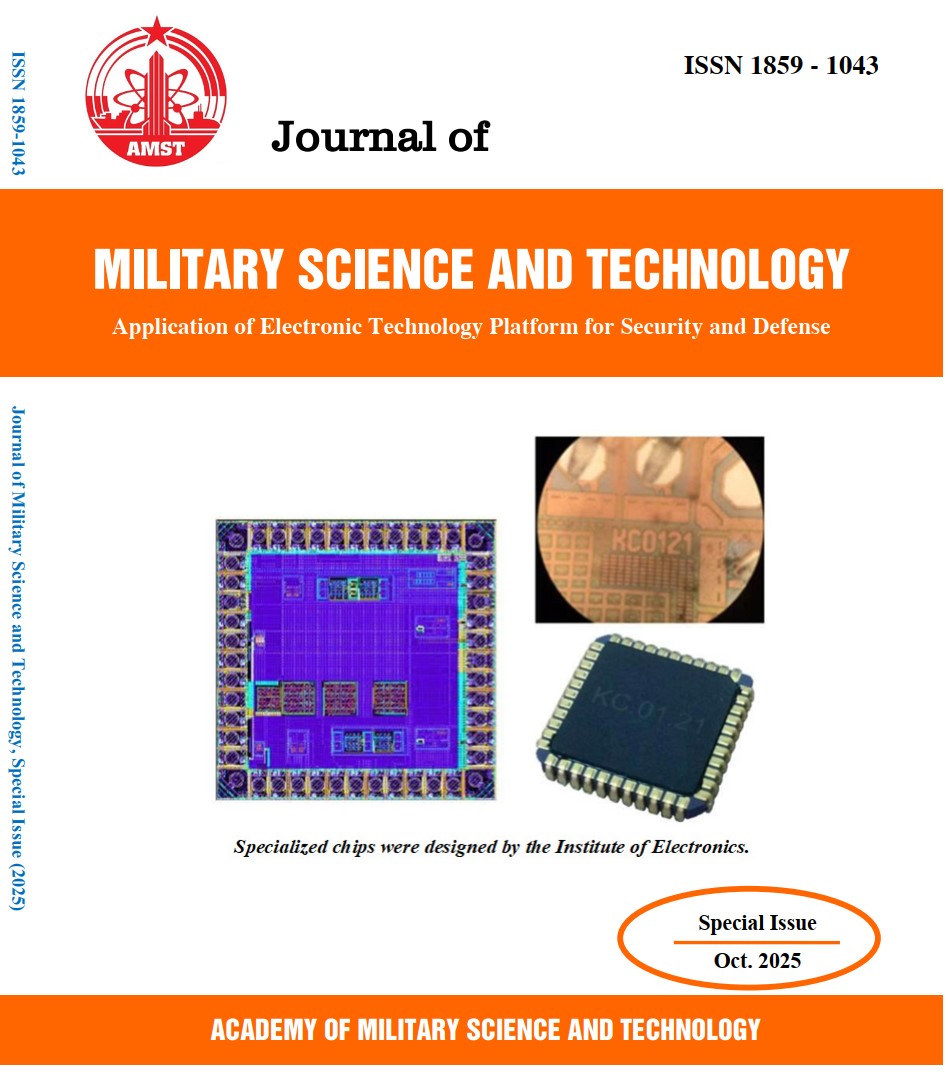Underwater communication system for shallow water environments using FSK modulation
290 viewsDOI:
https://doi.org/10.54939/1859-1043.j.mst.IITE.2025.107-114Keywords:
Underwater acoustic; FSK modulation; Matched filter.Abstract
Underwater acoustic communication presents significant challenges due to complex environmental factors such as noise, multipath propagation, and time-varying channel conditions. This paper presents an underwater communication system employing Frequency Shift Keying (FSK) modulation with matched filter-based demodulation to mitigate the impact of noise in shallow water environments, suited to Vietnam’s marine area. By leveraging the optimal signal detection capability of the matched filter in noisy and time-varying channels, the system significantly improves communication reliability under harsh underwater conditions. Simulation results demonstrate that the proposed FSK-based system achieves a bit error rate (BER) below 10⁻³ at a signal-to-noise ratio (SNR) exceeding 20 dB. These findings suggest that FSK modulation, combined with matched filter demodulation, is a suitable solution for underwater communication in shallow water scenarios.
References
[1]. L. M. Brekhovskikh et al., “Fundamentals of ocean acoustics,” Springer, Berlin, no. 3rd ed., pp. 140–146, (2003).
[2]. Z. Li et al., “Underwater acoustic communications,” Nature reviews electrical engineering, Vol. 2, pp. 83–95, (2025). DOI: https://doi.org/10.1038/s44287-024-00122-w
[3]. M. M. Dawoud et al., “Experimental realization of ASK underwater digital acoustic communications system using error correcting codes,” International journal of electronics, Vol. 72, No. 2, pp. 183–196, (1992). DOI: https://doi.org/10.1080/00207219208925568
[4]. L. Araujo et al., “4-FSK high-speed underwater acoustic communication system,” OCEANS 2023 - Limerick, Limerick, Ireland, pp. 1–5, (2023). DOI: https://doi.org/10.1109/OCEANSLimerick52467.2023.10244623
[5]. L. M. Wolff et al., “Bitwise ranging through underwater acoustic communication with frequency hopped FSK utilizing the Goertzel algorithm,” OCEANS 2017 - Aberdeen, Aberdeen, UK, pp. 1–6, (2017). DOI: https://doi.org/10.1109/OCEANSE.2017.8084732
A. Soulias et al., “Coherent phase shift keying (PSK) modulation using low-power micro-controllers for underwater acoustic communications,” OCEANS 2022, Hampton Roads, VA, USA, pp. 1–6, (2022). DOI: https://doi.org/10.1109/OCEANS47191.2022.9977244
[6]. Deshpande et al., “Underwater acoustic OFDM systems using deep neural network,” 3rd international conference on intelligent engineering and management (ICIEM), London, United Kingdom, pp. 195–200, (2022). DOI: https://doi.org/10.1109/ICIEM54221.2022.9853103
[7]. S. Zhou et al., “OFDM for underwater acoustic communications,” John Wiley Sons, Ltd, Vol. 9781118458860, pp. 1–386, (2014). DOI: https://doi.org/10.1002/9781118693865
[8]. Tran Cao Quyen, “Nâng cao tốc độ truyền tin trong một kênh nước biển nông thuộc vịnh Bắc Bộ của Việt Nam dùng điều chế OFDM,” National Conference on Electronics, Communications and Information Technology, (2015) (in Vietnamese).
[9]. Y. T. Chan et al., “Comparison of two FFT-based demodulation schemes for M-ary FSK,” MILCOM 92 conference record, San Diego, CA, USA, Vol. 2, pp. 603–607, (1992). DOI: https://doi.org/10.1109/MILCOM.1992.244007
[10]. W. Xiang et al., “FPGA-based two-dimensional matched filter design for vein imaging systems,” IEEE journal of translational engineering in health and medicine, Vol. 9, Art. no. 1800510, (2021). DOI: https://doi.org/10.1109/JTEHM.2021.3119886
[11]. J. Kaur et al., “Performance evaluation of matched filter detection using QAM technique in CR networks in different channel conditions,” IEEE 11th Uttar Pradesh section international conference on electrical, electronics and computer engineering (UPCON), Lucknow, India, pp. 1–4, (2024). DOI: https://doi.org/10.1109/UPCON62832.2024.10983782
[12]. M. B. Porter, “The BELLHOP manual and user’s guide: preliminary draft,” Heat, Light, and Sound Research, Inc., La Jolla, CA, USA, Tech. Rep., Vol. 260, (2011).
[13]. D. V. Ha et al., “Methods of designing shallow underwater acoustic channel simulators,” Acoustics Australia, pp. 439–448, (2016). DOI: https://doi.org/10.1007/s40857-016-0074-3







